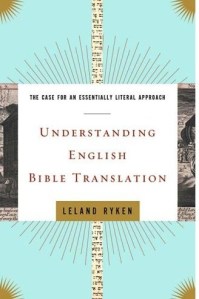Book Review: Understanding English Bible Translation


Understanding English Bible Translation: The Case for an Essentially Literal Approach, Leland Ryken, Wheaton: Crossway Books, 2009. Paperback, 208 pages, $15.75
The two most highly emotional and controversial issues in church life have to be music and Bible translations. Both have the potential to be hugely divisive and both find people with very strong opinions. I admit to being one of those people when it comes to Bible translations. In the mid-1990s, the Canadian Reformed Churches were entertaining a change from the commonly-accepted Revised Standard Version to the New International Version (NIV). Our Synod Abbotsford in 1995 decided to recommend the NIV for use in our churches. I thought that was a mistake then and I still think it was a mistake today. Our churches could have done better then and they could surely do better now. After ten years of preaching with it, I’m still not impressed with the NIV. So, obviously, Leland Ryken didn’t have to convince me that an essentially literal Bible translation is to be preferred. Nor did he need to persuade me of the problems with a dynamic equivalent translation or translations that lean in that direction (like the NIV).
Ryken is a professor of English at Wheaton College and was involved with the production of the English Standard Version (ESV). Obviously, he is not unprejudiced and that’s reflected throughout the book. While he nowhere comes right out and endorses the ESV, it’s quite obvious that the conclusion the reader should reach is that the ESV is the translation conservative Bible-believing Christians and churches should be using. It is also difficult to miss the fact that this book is published by Crossway, the same company that publishes the ESV.
Understanding English Bible Translation briefly surveys the history of the English Bible. What follows is a comparison of the “two main genres of English Bible Translation.” By “genre,” Ryken means “approaches,” and those two main approaches, of course, are either essentially literal or dynamic equivalent. Ryken extols the virtues of the essentially literal approach, while exposing all the warts and blemishes of the dynamic equivalent. To be fair, he does see some value in dynamic equivalent translations. They are useful as commentaries on Scripture. Part Four outlines Ryken’s expectations for an “Ideal English Bible Translation.” Putting all of this together, one reaches the conclusion that the ESV is about as close to ideal as you can get. The final part of the book deals with the use of the Bible in Christian churches. He rightly outlines the problems that arise in church life from the use of dynamic equivalent editions of the Bible. Especially when it comes to preaching and teaching, it is preferable to have a Bible that provides minimal interpretation and protects the “exegetical potential” of the biblical text.
As mentioned above, Ryken didn’t need to persuade me. However, I’m afraid that he might have a difficult time persuading those who are not already persuaded. He exposes the elitism and snobbery of proponents of the dynamic equivalent approach. He quotes Eugene Nida: “The average reader is usually much less capable of making correct judgments…than is the translator, who can make use of the best scholarly judgments” (31). However, it seems to this reviewer that Ryken falls into a similar trap when he alleges that those who hold to the dynamic equivalent approach view “the Bible as a deficient book in which the authors miscalculated what readers can handle” (149). Elsewhere he writes that these translators are set on correcting the Bible. This seems to be a caricature and less than charitable. I find it difficult to believe that these translators actually believe the Bible to be deficient – Ryken certainly doesn’t provide any quotes to support such an allegation. Their views would seem to be more nuanced than that.
Ryken is a professor of English literature and the value he places on literary quality undoubtedly is related to that. He argues that “the Bible is a literary anthology,” and that “a translation is adequate only if it respects the literary nature of the Bible” (140). According to Ryken, literary writing is “overtly artistic” and rises above the level of ordinary conversation in terms of vocabulary and syntax. He maintains that the Bible is literary writing. There is some truth to this argument, but I do think that Ryken pushes it beyond the reality of the original Hebrew and Greek texts. The reality is that there is literary unevenness in both the Hebrew Old Testament and Greek New Testament. Some of the human authors possessed obvious literary gifts, while others were more earthy. Shouldn’t an essentially literal translation reflect the diversity in literary quality found in the original texts? Or does the essentially literal translator envisioned by Ryken have the responsibility to bring up the level, i.e. to “correct” the Bible?
That criticism notwithstanding, the author raises many good and helpful points. I share his concern that dynamic equivalent translations (or translations that lean in that direction) impel Christians and churches to theological impoverishment. A translation that often has to be corrected from the pulpit has the potential to corrode the credibility of the Word of God for the regular person in the pew. Essentially literal translations in the footsteps of the KJV are definitely to be preferred. I only wish that Ryken had tempered some of his rhetoric – if he had done so this could have been a book to highly recommend. In the meantime, the NIV as we know it is going out of print. What will replace it is unknown at this time, but it may very well be an edition that includes gender-neutral language. This could be the time for the Canadian Reformed Churches (and others) to move back to an essentially literal translation.


